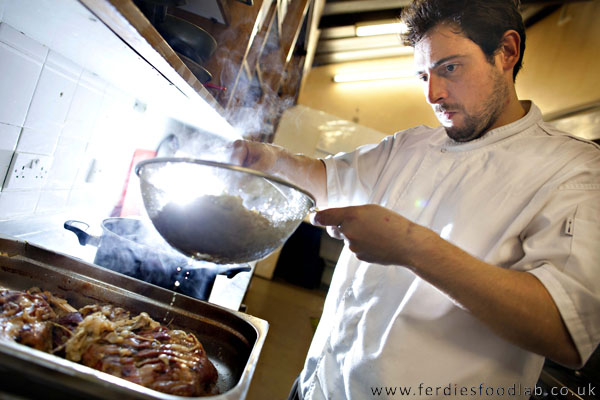
It's always fun to try new techniques, sometimes it's a disaster and you learn a great deal, sometimes it's a disaster and it takes 3 more attempts to get even close to the desired result - (bread was a good example of this one for me) and some, like this one, are nice and easy, and it's simple enough to get the desired taste.
ingredients (makes ~70g)
for the orange powder
300g sugar
50ml water
6 oranges (zest only)
 Add zest to syrup Add zest to syrup |
 Reduce 20mins Reduce 20mins |
 Pour out onto silicone Pour out onto silicone |
 Spread out Spread out |
 Dehydrate in oven 50C Dehydrate in oven 50C |
 Crunchy Nut Corn Flakes! Crunchy Nut Corn Flakes! |
method
Zest oranges - therein lies the trick! The important thing is to get as little pith (the white bit between the orange flesh and the outer skin) as possible. You could use a zester, but you lose half of the zest. A micro plane the best way to go - quite expensive. Or a speed peeler and a bit of practice!
The orange on the left is attempt 1, the orange on the right is after about 4 oranges. It's important to use the sharp edge of the peeler almost like a knife. That is, moving it sideways almost like a knife, instead of using it like a peeler.
Once you have acquired your zest, add a 5mm depth of water to your pot, then pour the sugar in the middle. Once all the sugar has turned translucent - as in it has fully adsorbed the water - give it a little stir until the sugar has dissolved in the water and add the zest. Leave it to simmer for 15-20 mins. Turn the heat off and let it cool a little. Turn it out once it's cold enough to handle, break it up and distribute it evenly on a silpat or some baking paper.
 Bake it for 60 - 90mins at 50C - the aim is to remove all the water from the zest and sugar.
Bake it for 60 - 90mins at 50C - the aim is to remove all the water from the zest and sugar.At this point you'd be forgiven for thinking 'crunchy nut cornflakes!!' - because they look so alike!!
Next step is to pop the crystallised sugar zest into a spice mill and turn it into powder
 Next make an OJ out of the oranges and time to start powdering everything to see what kind of cracking pairing I can come up with for the banquet!
Next make an OJ out of the oranges and time to start powdering everything to see what kind of cracking pairing I can come up with for the banquet!variations
This dehydration technique can be used on all manner of things.
Right time to start dusting everything with orange powder - dust, dust, dust . . . . . : )

















